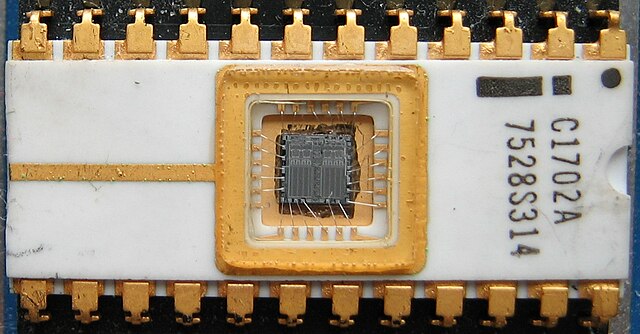An EPROM, or erasable programmable read-only memory, is a type of programmable read-only memory (PROM) chip that retains its data when its power supply is switched off. Computer memory that can retrieve stored data after a power supply has been turned off and back on is called non-volatile. It is an array of floating-gate transistors individually programmed by an electronic device that supplies higher voltages than those normally used in digital circuits. Once programmed, an EPROM can be erased by exposing it to strong ultraviolet (UV) light source. EPROMs are easily recognizable by the transparent fused quartz window on the top of the package, through which the silicon chip is visible, and which permits exposure to ultraviolet light during erasing.
An EPROM: the Texas Instruments TMS27C040, a CMOS chip with 4 megabits of storage and 8-bit output (shown here in a 600-mil ceramic dual-in-line package). The TMS27C040 operates at 5 volts, but must be programmed at 13 volts.
An Intel 1702A EPROM, one of the earliest EPROM types (1971), 256 by 8 bit. The small quartz window admits UV light for erasure.
Atmel AT27C010 - an OTP EPROM
K573RF1
A programmable read-only memory (PROM) is a form of digital memory where the contents can be changed once after manufacture of the device. The data is then permanent and cannot be changed. It is one type of read-only memory (ROM). PROMs are used in digital electronic devices to store permanent data, usually low level programs such as firmware or microcode. The key difference from a standard ROM is that the data is written into a ROM during manufacture, while with a PROM the data is programmed into them after manufacture. Thus, ROMs tend to be used only for large production runs with well-verified data. PROMs may be used where the volume required does not make a factory-programmed ROM economical, or during development of a system that may ultimately be converted to ROMs in a mass produced version.
Texas Instruments PROM type TBP18SA030N





